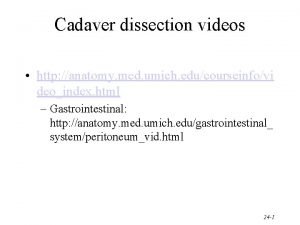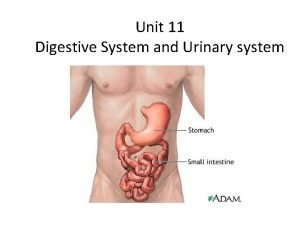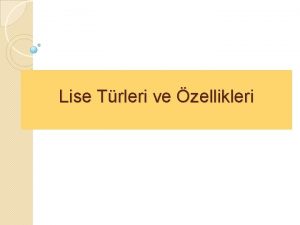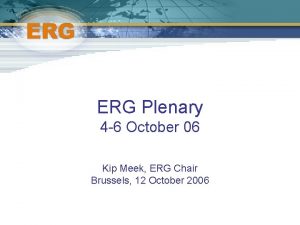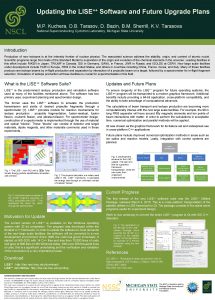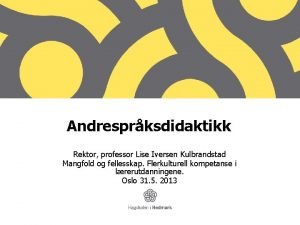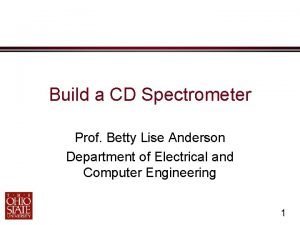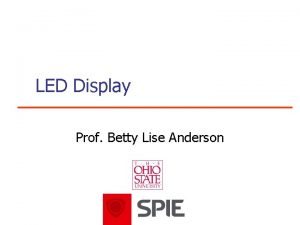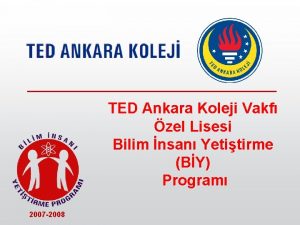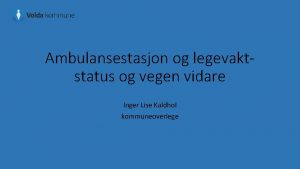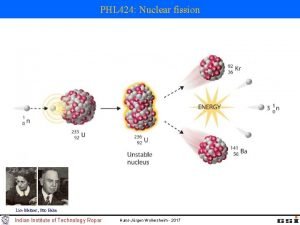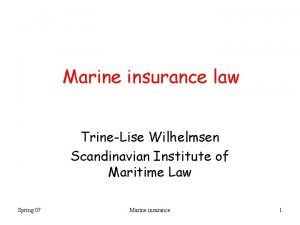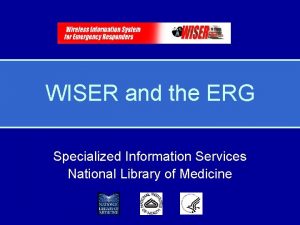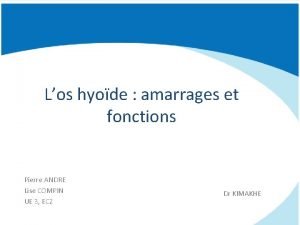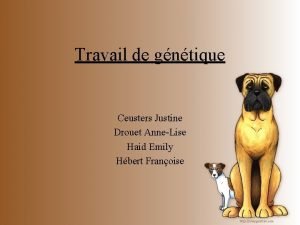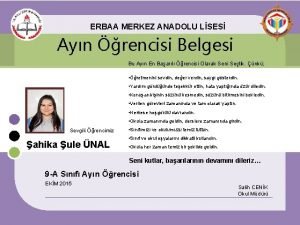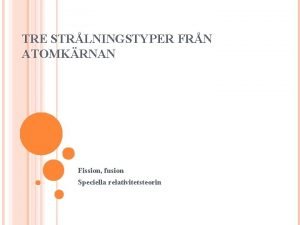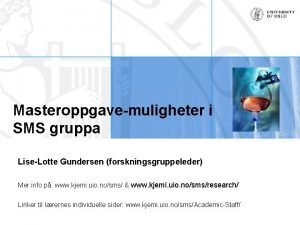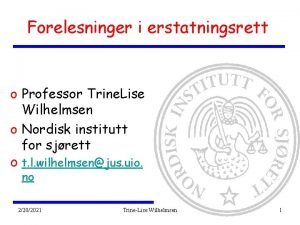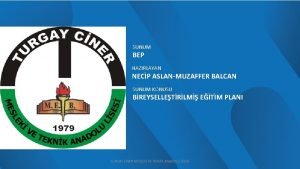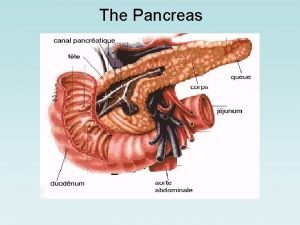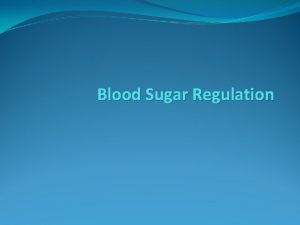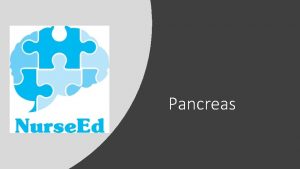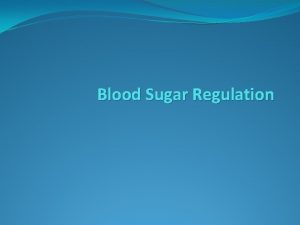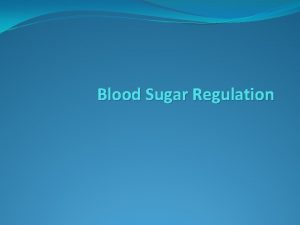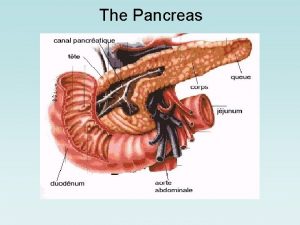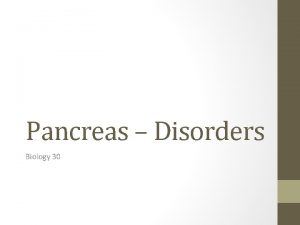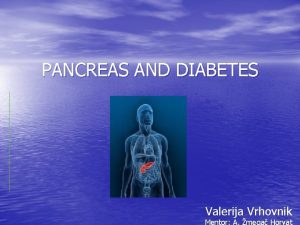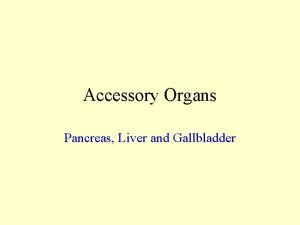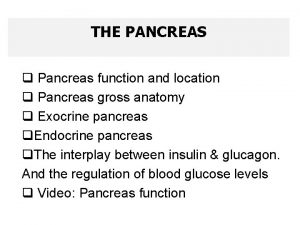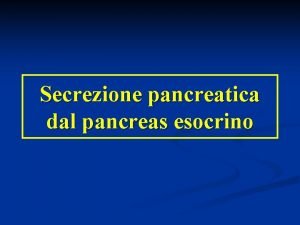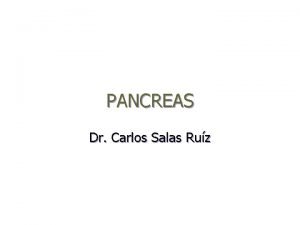The pancreas Surg Anatomy 1 The pancreas lise





































- Slides: 37




The pancreas � Surg. Anatomy � 1 The pancreas lise in a retro peritoneal retrogastric position so much of it is hidden from view. So injuiries or tumours may escape casual ex pl. � 2 It has relativly fixed position in close promiximity to the vent. Column So it is susceptible to injurs by blunt trauma. � 3 Low rate of resectability and `curability of ca. Pancreas' , due to: � a lack of mesentery → direct invasion of the post abd. wall � b the pancreatic lymph drayage is to several groups of lymph nodes, excision of these nods is accomplished only with a node picking procedure rather than en block procedure, � 4 Because of the joint blood supply of the head of the pancreas and the 2 nd portion of the duodenum. It is not possible to excise the head of pancreas without simultaneous duodenectomy "whipple's op"

� 5 The body and tail of the pancreas are drained by small veins into the splehic veins, these veins are fragile and easily torn during dissection so resection of the body and tail of the pancreas is frequently combined with splenectomy. � 6 In it's transverse course the pancreas pass immediately anterior to the great vessels of the abdomen. So in both penetrating and' non penetrating injuries of. the pancreas there is the possibility of injuries to the vessels and �a The pancreas may obscure the site of Hge. �b Extensive' mobilization or even transection of the pancreas may be necessary to control bleeding. �c In necrotizing , Hgic pancreatitis these great vessels may be �eroded →severe Hge.

Methods of investigation �(1) Procedures which outline the gland. � 1 - Direct imaging procedures to visualize � � � Parenchyma Duct system � �Ultrasonography ERCP �CT scanning �Isotope sea nning � � 2 Indirect imaging � Barium meal. � Hypotonic duodenogrphy. vasculature angiography

�(2) Procedures to test exocrine function. � Foecal fat. � Duodenal intubation (secretions csk pan test) � 3) Procedures to test endocrine function: �Fasting Blood. sugar. �Hormonal assay. � Insulin Glucagon Gastrin

�(4) Analysis of serum for markers of pancreatic diseases: � Enzymes �Amylase �Lipase. �Trypsin � Tumour marker CEA �(5) Pancreatic Biopsy, cytology: �Pancreatic needle aspiration cytology under ultrasound and CT guidance. �Endoscopic transdudenal aspiration cytology �Operatice biopsy �

Congenital anomalies of the pancreas � 1. Ectopic pancreas �Pancreatic tissue in ectopic sites: �Wall of the stomach, duodenum or jejunum �Mickels diverticulum. �Mesentery, omentum.

� 2. Annular pancreas �A ring of, pancreatic tissue surrounding the second part of the duodenum, usually proximal to the ampulla of Vater. The pancreatic tissue is firmly attached to the wall of the duodenum and is not separable from it. �Main symptom: Non bilious vomiting �Plain x-ray shows: �Distended stomach. �Double"' bubble sign at the level of the, duodenum �The, operation is duodeno stomy or duodenojejunostomy.

Pancreatitis �Non Bact. Inflammatory disease caused by: �Activation, interstitial liberation and autodigestion of the pancreas by its own enzymes. �-Clinical types "Marseilles classification". � 1 -Acute pancreatitis �Single episode of pancreatitis in a previously normal gland � 2 -Recurrent acute pancreatitis �Recurrent attacks of pancreatitis which don't lead to permanent functional damage. "clinical, biological normal in interval between the attacks".

� 3 - Recurrent chronic pancreatitis �Progressive functional damage persisting between the attacks but with pain free intervals. . � 4 -Chronic pancreatitis �Irreversible datiage of pancreatic function. �Constant pain

Etiological causes of pancreatitis � 1 Biliarypancreatitis. � 2 Alcohol pancreatitis. � 4 1 diopathi pancreatitis. � 5 Heredofamill'al, hyperlipedemia, protein def. . � 6 Hypercalcaemia "hyperparathyrodism". � 7 Mumps. � 8 Drugs corticosteroids , androgen, thiazid. � 9 Congenital factors " rare".

Pathogenesis of acute pancreatitis �The finding of pancreatic enzymes in ascetic fluid and the amounts of phospholipase A and lysolith in pancreatic tissue in patients with acute pancreatitis. Supports the concept that pancreatitis' is due to auto digestion of the gland. �Phospholipase A In presence of bile salts lysolecit � Attack phospholipids "Lecithin" �Lysolecithins potent compounds" Produce severe Necrotizing pancreatitis

� 2 Elastase has. � � Proteolytic Elastolytic actions Digest the wall of bl. v Hgic pancreatitis Earlier steps ''that account for presence "of active enzymes in the ducts and their escape into the interstitium

�Theories �Obst. secretion theory �Common channel theory �. Destruction of pancreatic duct barier � 1 -Biliary pancreatitis � 40% of acute pancreatitis �no permanent pancreatic damage �eradication of biliary disease always prevents rec attacks Mecamsm: �Obst. of ampulla of vater & panc. duct → reflux of bile, and panc secretions into pancreas

� 2 -Alcoholic pancreatitis-: � 40 % of cases � 6 years or more of al 6 ohol excess preceds the initial Attack produces permanent pancreatic damage → ch. pane. �

�Mecanism: � Stimulation of pancreatic secretion & in the same time spasm of sph. . of Oddi. � Toxic actiop of alcohol on parenchyma � lmpairmeni of ductal barrief � 3 - Hypercalcemia causes : � 1 Premature activation of pane. enzymes � 2 Deposition of Calculi'. in the ducts

� 4 -Traumatic pancreatitis. * �. � Accide. Md. Trauma �Coledochlithotomy � �*Jong arm T tube. Endoscopic Operative Open op Gastric op. (billorn II with a long aff. loop) (pancreatic biopsy) �Excess dilatation of the common bile cuct by the dilator. �

Acute pancreatitis �Acute oedematous pancreatitis �The glandular tissue and surrounding retro — peritoneal structures are engorged with interstatial fluids and the pancreas is infiltrated with inflammatory cells surrounding small foci of parenchymal necrosis. �Acute-Hizic pancreatitis �Characterized by extensive severe pancreatic necrosis with bleeding into the parenchyma and surrounding retro peritoneal tissue.

�Clinical manifestation of acute pancreatitis �Severe epigastric pain radiating to the back. � Vomiting. �Shock, which may be profound with dehydration and collapse. �Abd. Exam: � 1 Generalized abd. tenderness rigidity or may be localized to the epigastrium. � 2 Ileus. � 3 May be palpable mass "swollon pancreas". � 4 Grey turner sign Cullen sign. � 5 Evidence of It pleural effusion.

�Laboratory investigation : � 4 a Haematocrite : dehydration � Hgic pant. �b Leucocytosis. �C Liver function. � Normal Usually but may be slight bilirubin �d ↑↑ ↑ Serum amylase. �e ↑↑↑ Urinary amylase. �↑↑↑ Se. amylase in different acute abd. conditions �So do iso enzymes �do amylase creatinine , Clearance.

�f Urinary amylase Serum amylase x serum creatinine Urinary creatinine �↑↑↑ More than 5% in pancreatitis �g ↓↓↓ Serum Calcium level. � calcium combines with fatty acids "liberated for retro peritoneal fat by lipase. �H ↑↑↑ serum lipase is more specific

�Radiological signs � 1 Senitinel loop sign. � 2. Colon cutoff sign. � 3. Radioopaque shadows: �Biliary stones. �Pancreatic calcification � 4. 1 t. Pleurall effusion. �Ultrasound pan CT scan �May show: � 1. Biliary stones. � 2. Odematous swollon pancreas. � 3. Abscess , cyst.

� �Complications of acute pancreatitis �pseudo cyst, Abscess. �GIT bleeding. �Intra peritoneal bleeding. �Pulmonary complications (It effusion hypoxia) �Involvement of transverse colon. �colonic obst. �Foecal fistula �It sided portal hypertension "thrombosis of spl. Vein" �

Glasgow system of prognostic factors �Age of the pt. >50 ys. �Leucocytosis WBCs >, 15000/mm 3 �Mood glucose >. 200 mg% in absence of DM �Blood urea > 40 mg% even after iv fluid �Arta: Pa. 02 < 60 mg% �Total Ca. < 8 mg% �Serum albumin < 3 gm% �LDH > 600 iu/L

�Glasgow criteria of acute pancreatitis �(8 Factors) � Age ↑↑ 55. � Leucocytic count ↑↑ 15000. � Glucose ↑↑ 180 � LDH ↑↑ 600 � Urea ↑↑ 96 � Calcium ↓↓ 8 � PAO 2 ↓↓ 60 � Albumin ↓↓ 3. 2 �The presence of any three of the eight signs at any time of admission indicate severe form of the disease.

Treatment of acute pancreatitis � � 1 -Rest: of the " pt, intestine, pancreas" �Complete bed rest. �No oral feeidng. �Nasogastric suction. �Anticholinergic � 2 - Fluid replacement, nutrition: � IV fluid therapy may be total parent N. � Albumin. � Blood transfusion in Hgic panc.

� 3 - Analgesics. � 4 - Calcium. � 5 -Oxygen. � 6 - Antiobiotics. � 7 - Cimetine, glucagons, trasylol � 8 - Peritoneal lavage. � Surgery in Acute pancreatitis � 1 Laparotomy for Diagnostic reason in doubtful cases. � 2 Surgery to remove necrotic tissue in and around pancreas. � 3 Surgery for biliary stone. � 4 Surgery for complication. � Abscess. Paseudocyst.

Procedures done in early laparotomy For acute pancreatitis �Sample from free fluid to: �Bioch for amylase albumin. �Bact. For culture. �If gall stones present � Cholecystectomy or cholecystostomy � OP. Cholangioraphy � C. B. D. expel. if possible. �Removal with core of necrotic tissue. �Placement of drainage, lavage procedures. �Feeding jejunostomy.

Acute pancreatitis in children �. Viral infection ( mumps ). �. Blunt abdominal trauma. �. Drug induced (uncommon ). �. Familial pancreatitis ( uncommon i. e : hypoprotinemia). �. Biliary (pigment stone ). �. Congenital anomalies (i. e annular pancrease). �. Round warms.

Chronic pancreatitis �Not generally considered a surgical disease. It needs : � Adequate nutrition. � Enzymes. � Insulin supplementation. � Manage addiction and alcoholism.

�. Not surgical procedure can �a. Restore exocrine or endocrine function of the pancreas. �b. Prevent further loss of gland function.

�. Converting the patient to insulin dependant by total pancreatectomy may be lethal and should be avoided �. Treatment of addiction and avoid alcoholism is very important.

Chronic pancreatitis �Triad : � weight loss. � DM. � steatorrhea. � �Common causes: � Alcoholism. � Hyper calcemia. � Heredo familial. � Trauma.

Indication of Surgery : � 1 -Relief of duct obst: � sphicteroplasty. � pancreatic duct drainage “pancreatico jejunostomy” � 2 -Relief of pain: � Interruption of splanch , N. � panc, Resection. � 3 -Management of complications: � Lower C. B. D obst. � Duodenal obst. � Cysts , panc , Ascites. � Spl. V. thrombosis with portal hypertension.

THANK YOU
 Pancreas anatomy and physiology
Pancreas anatomy and physiology Anatomy of the pancreas
Anatomy of the pancreas Cadaver stomach labeled
Cadaver stomach labeled Physiology
Physiology Gross anatomy of the gallbladder pancreas and bile passages
Gross anatomy of the gallbladder pancreas and bile passages Lise türleri ve özellikleri
Lise türleri ve özellikleri Pps chez lise
Pps chez lise Lise kılık kıyafet yönetmeliği
Lise kılık kıyafet yönetmeliği Akran zorbalığı sunum
Akran zorbalığı sunum Erg inscription
Erg inscription Lise erg
Lise erg Lise++
Lise++ Keylozis nedir tıp
Keylozis nedir tıp Lise kulbrandstad
Lise kulbrandstad Cereal box spectrometer
Cereal box spectrometer What's this
What's this Ted lise hazırlık atlama sınavı soruları
Ted lise hazırlık atlama sınavı soruları Purchasing flashing injection moulding
Purchasing flashing injection moulding Inger lise kaldhol
Inger lise kaldhol Nuclear fission lise meitner
Nuclear fission lise meitner Trine-lise wilhelmsen
Trine-lise wilhelmsen Lise gingras
Lise gingras Lise erg
Lise erg Muscle génio hyoïdien
Muscle génio hyoïdien Justine drouet
Justine drouet Ayın öğrencisi belgesi
Ayın öğrencisi belgesi Lise meitner
Lise meitner Nordberg skole
Nordberg skole Lise ahlmann selvhjulpenhed
Lise ahlmann selvhjulpenhed Lise-lotte gundersen
Lise-lotte gundersen Trine-lise wilhelmsen
Trine-lise wilhelmsen Bep toplantısı alınan kararlar örneği
Bep toplantısı alınan kararlar örneği Mật thư tọa độ 5x5
Mật thư tọa độ 5x5 Các châu lục và đại dương trên thế giới
Các châu lục và đại dương trên thế giới Thang điểm glasgow
Thang điểm glasgow ưu thế lai là gì
ưu thế lai là gì Thẻ vin
Thẻ vin Tư thế ngồi viết
Tư thế ngồi viết


